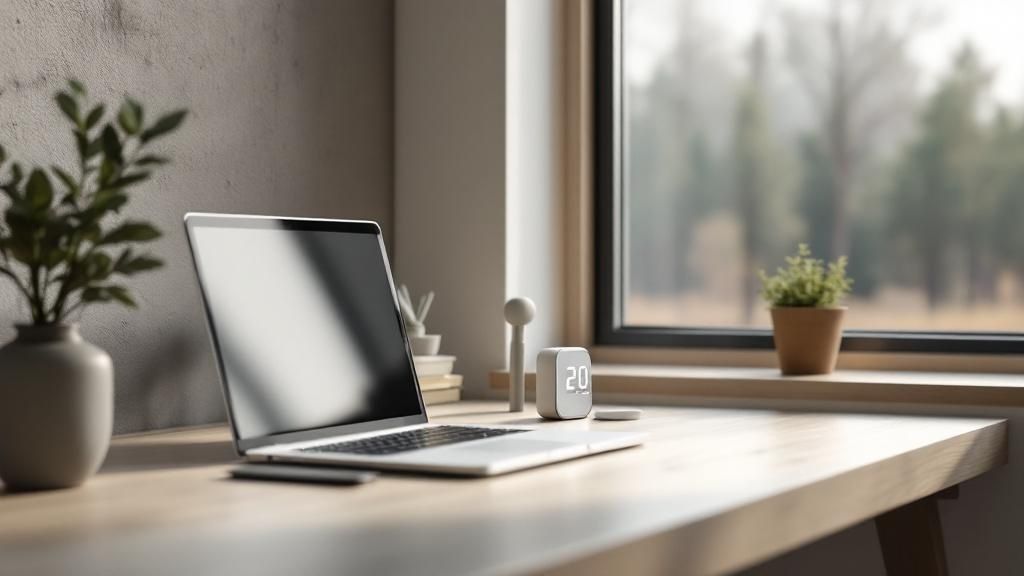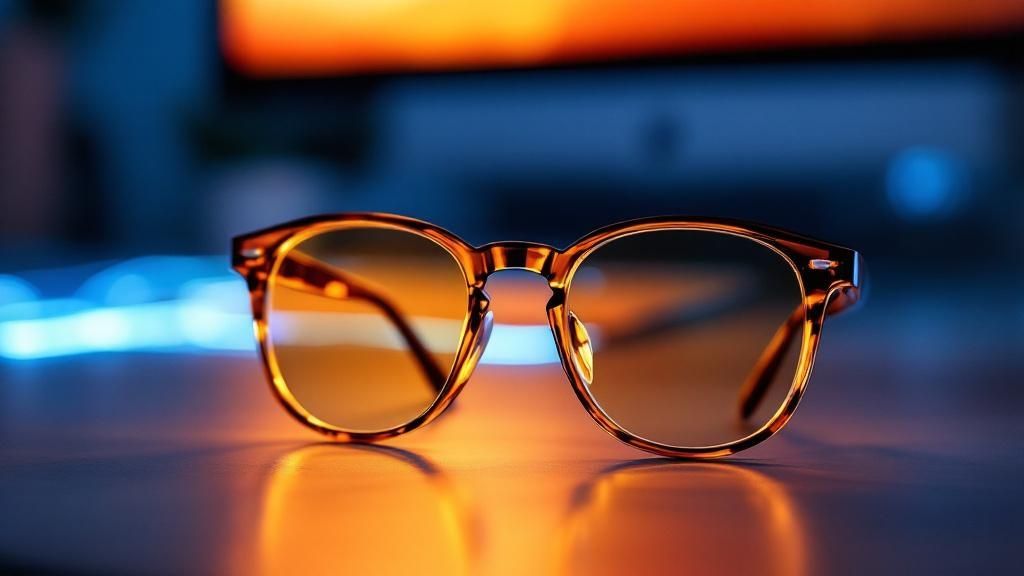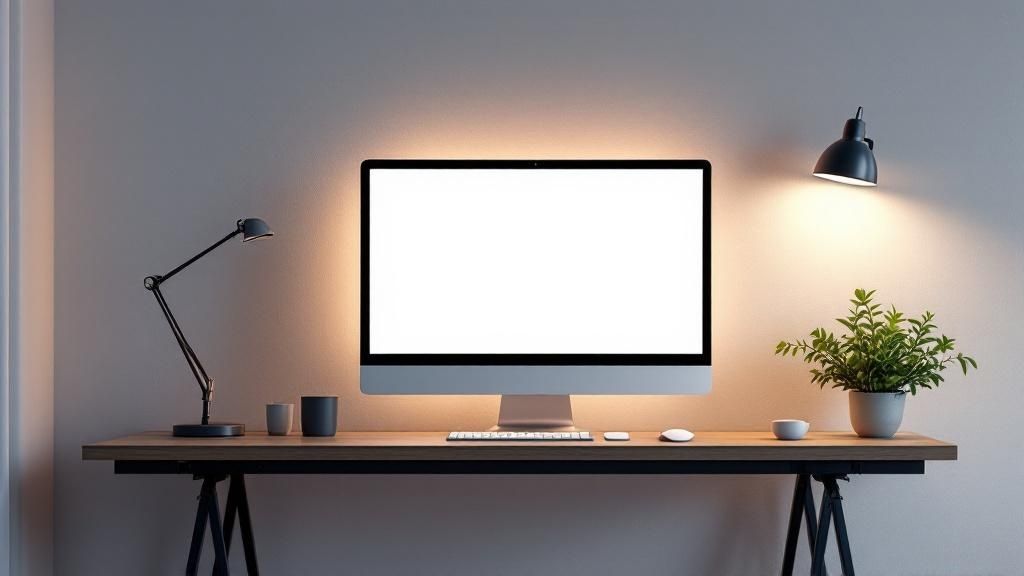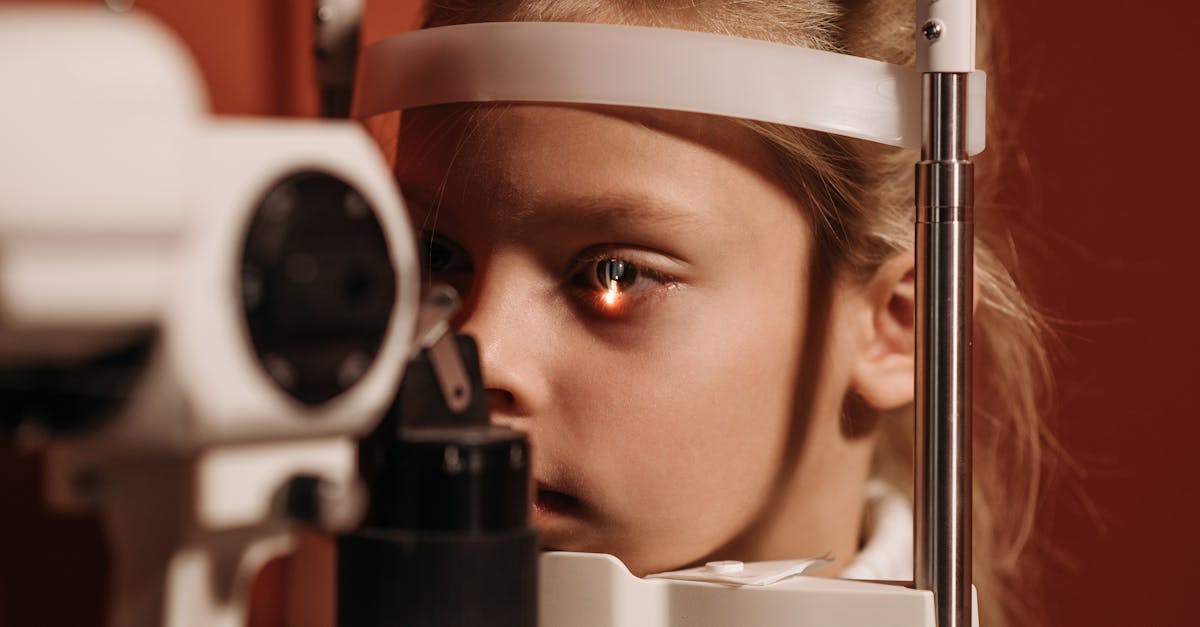In our hyper-connected world, that dull, throbbing headache behind your eyes has become an unwelcome, yet frequent, guest. For residents of Glendale Heights, navigating busy local roads like North Avenue or Army Trail Boulevard is challenging enough without a persistent eye strain headache. Whether you're a student at Glenbard East High School or working from a home office near Camera Park, our eyes are under constant pressure, leading to significant discomfort.
This guide provides eight practical and actionable strategies for effective eye strain headache relief, helping you find comfort and reclaim your focus. We'll explore simple adjustments you can make to your daily routine, from ergonomic setups to specific eye exercises and advanced lens technologies. At iDoctor, a premier optometry boutique in Glendale Heights, we believe that understanding how to care for your eyes is the first step toward lasting wellness.
Before trying these remedies, remember that persistent or severe headaches require a professional evaluation. Scheduling a detailed eye exam in Glendale Heights can rule out underlying vision problems and ensure your prescription is perfectly optimized for your visual demands. Let’s explore proven methods to soothe your eyes and put an end to digital discomfort for good.
1. Master the 20-20-20 Rule: Your First Line of Defense
If you spend hours focused on digital screens, the 20-20-20 rule is one of the most effective and simplest methods for immediate eye strain headache relief. Popularized by the American Optometric Association, this technique is designed to give your focusing muscles a much-needed break. The concept is straightforward: every 20 minutes, you take a 20-second break to look at an object at least 20 feet away.
This simple action allows the ciliary muscles inside your eyes, which contract to help you see close-up objects, to relax. Constant near-focus work, like staring at a computer or phone, leads to muscle fatigue, a primary cause of eye strain, dryness, and the persistent headaches that often follow. By intentionally shifting your focus to a distant object, you interrupt this cycle of strain before it escalates.
How to Implement the 20-20-20 Rule
Making this rule a consistent habit is key to its success. Here are some actionable tips to integrate it into your daily routine, whether you're working in an office in Glendale Heights or from home:
- Set Automated Reminders: Use your phone alarm, computer calendar, or a dedicated browser extension like Stretchly to alert you every 20 minutes. Consistency is crucial.
- Identify Your "20-Foot" Spot: Before you start work, find a specific distant object to look at. This could be a tree outside your window, a building across the street, or a picture on a far wall. Having a pre-selected target makes the break effortless.
- Combine and Conquer: Use your 20-second break for more than just looking away. This is a perfect opportunity to consciously blink several times to re-moisturize your eyes, take a sip of water, or do a quick neck and shoulder stretch.
The effectiveness of this method is so recognized that major tech companies like Microsoft have integrated similar break reminders into their wellness software. If eye strain symptoms persist despite these efforts, it may be time for a professional evaluation. Scheduling one of our detailed eye exams in Glendale Heights can help identify any underlying issues and ensure your prescription is perfectly suited for your digital lifestyle.
2. Embrace Blue Light Filtering for Digital Comfort
In our screen-dominated world, your eyes are constantly exposed to high-energy visible (HEV) light, commonly known as blue light. While some blue light exposure from the sun is natural, the prolonged, close-range exposure from digital devices can contribute to digital eye strain and the associated headaches. Embracing blue light filtering is a proactive step toward achieving significant eye strain headache relief. This technology works by blocking or absorbing a percentage of blue light wavelengths before they reach your eyes, reducing visual stress and potential sleep cycle disruption.
This method tackles a modern problem directly. The shorter wavelengths of blue light scatter more easily than other colors, making it harder for your eyes to focus. This unfocused visual "noise" forces your eye muscles to work harder, leading to fatigue, strain, and headaches. By filtering this light, you create a clearer, more comfortable visual experience.
How to Implement Blue Light Filtering
Integrating blue light filtering is easier than ever with multiple options available to fit any lifestyle. Here are some effective strategies to reduce your exposure:
- Utilize Built-In Software: Most modern devices have integrated solutions. Activate "Night Shift" on Apple products or "Blue Light Filter" (sometimes called "Eye Comfort Shield") on Android and Windows devices. These settings automatically warm the screen's color temperature, especially in the evening.
- Try Dedicated Applications: For more control, software like f.lux automatically adjusts your screen’s color based on the time of day, syncing with the natural light cycles in Glendale Heights to ease the transition from daytime work to evening relaxation.
- Invest in Specialized Eyewear: For a constant layer of protection, consider glasses with blue light filtering lenses. These are available in both prescription and non-prescription forms. They are an excellent solution if you use multiple devices or work under harsh fluorescent office lighting. At iDoctor, we offer designer eyeglasses from brands like Tom Ford and Gucci that can be fitted with advanced blue light protection.
The benefits of this approach are widely recognized, from gaming communities to office workers. If you are curious about how this technology could work for you, you can learn more about the benefits of blue light glasses. Our team at iDoctor can help you explore premium lens options from top brands that incorporate this protective technology, ensuring both style and comfort.
3. Proper Screen Positioning and Ergonomics
Your workstation setup is a critical, yet often overlooked, factor in the fight for eye strain headache relief. Proper ergonomics involves more than just a comfortable chair; it’s about positioning your entire workspace, especially your computer screen, to reduce physical stress on your eyes and neck. An improperly positioned monitor can force you to squint, hunch, or hold an unnatural posture, all of which directly contribute to tension headaches and visual fatigue.
This principle is a cornerstone of occupational health, championed by physical therapists and workplace wellness consultants. By creating an environment that supports your body’s natural alignment, you prevent the cumulative strain that builds up during long hours of digital work. This proactive adjustment can make a significant difference in your daily comfort and productivity.
How to Implement Proper Ergonomics
Optimizing your workspace doesn't require a complete overhaul. Small, intentional changes can yield substantial benefits. Here are actionable tips for anyone working from an office in Glendale Heights or a home setup nearby:
- Mind Your Monitor Height: Position your screen so the top is at or slightly below eye level. You should be able to look at the center of the screen by glancing slightly downward, not up or straight ahead. Use a stack of books or a dedicated monitor stand to achieve the right height.
- Keep Your Distance: Your screen should be about an arm's length away (roughly 20-25 inches). This distance allows you to see the entire screen clearly without excessive eye movement or straining to read small text. Adjust your font size if needed.
- Angle for Comfort: Tilt your monitor slightly upward (about 10-20 degrees) to minimize reflections and glare from overhead lighting. This also aligns with your natural downward gaze. Combining this with the right eyewear can be even more effective; you can learn more about anti-glare glasses benefits on idoctoril.com to further reduce visual discomfort.
- Support Your Body: Ensure your feet are flat on the floor with your knees at a comfortable 90-degree angle. Your chair should support your lower back, and your keyboard should be positioned so your elbows are bent at about 90 degrees. This holistic approach prevents neck and shoulder tension from radiating into a headache.
4. Artificial Tear Drops and Eye Lubrication
When your eyes feel gritty, tired, and a headache is brewing, the culprit is often dryness. Staring at screens dramatically reduces your blink rate, which disrupts the natural tear film that protects and lubricates your eyes. Using over-the-counter artificial tears provides direct and effective eye strain headache relief by replenishing this essential moisture.
These lubricating drops work by supplementing your natural tears, stabilizing the tear film, and washing away irritants from the ocular surface. This instantly soothes discomfort and can prevent the dry-eye-induced tension headaches that many people experience after long hours of computer work or reading. Keeping your eyes properly lubricated is a simple yet powerful step to maintain comfort and clarity.
How to Implement Artificial Tears Effectively
Choosing and using the right eye drops can make a significant difference. Here are some actionable tips to integrate them into your routine for maximum benefit:
- Choose Preservative-Free: If you need to use drops more than four times a day, opt for preservative-free formulas, which come in single-use vials. This minimizes the risk of irritation from preservatives. Brands like Refresh Plus are commonly available and are an excellent choice for frequent application.
- Apply Proactively: Don't wait for symptoms to become severe. If you know you have a long day of screen time ahead, apply lubricating drops preventatively. Popular options include Systane Ultra for general use and TheraTears, which is specially formulated for computer-related dryness.
- Store for Soothing Relief: For an extra refreshing sensation, store your bottle of artificial tears in the refrigerator. The cool liquid can provide immediate, soothing relief for tired, inflamed eyes.
- Combine with Blinking: Using drops is not a substitute for blinking. Make a conscious effort to blink fully and frequently after applying drops to help spread the lubricant evenly across your entire eye surface.
While over-the-counter drops are a great first step, persistent dryness may require a more tailored approach. You can explore various dry eye treatment options to understand the different solutions available. If your symptoms don't improve, scheduling a consultation with the best optometrist in Glendale Heights can help us determine the best course of action for your specific needs.
5. Optimize Your Ambient Lighting
The harsh contrast between a bright screen and a dark room is a significant, yet often overlooked, cause of eye fatigue. Optimizing your ambient lighting involves strategically adjusting your room's illumination to minimize this contrast. This prevents your eyes' pupils from constantly dilating and constricting, reducing the muscular effort that directly contributes to eye strain headache relief.
This principle, long understood by photographers and lighting designers, ensures your eyes aren't fighting a visual battle between your monitor and your environment. When the light around you is balanced with your screen's brightness, your visual system can relax. This creates a more comfortable viewing experience, whether you're working on a spreadsheet or enjoying a late-night gaming session.
How to Implement Proper Lighting
Creating a visually comfortable workspace is key to preventing headaches. You don't need a complex studio setup; a few intentional adjustments can make a world of difference for anyone working near Glendale Heights.
- Avoid Direct Glare: Position your primary light source to the side of your computer screen, never directly behind you or in front of the monitor. Light from behind creates distracting reflections, while light in front forces you to squint.
- Use Bias Lighting: Consider a monitor light bar, like the BenQ ScreenBar, or even simple LED strips behind your monitor. This "bias lighting" creates a soft glow around your screen, reducing the stark contrast and easing the strain on your eyes.
- Match Light to the Time of Day: Use warmer, softer light (around 3000K) in the evening to align with your body's natural circadian rhythm. During the day, brighter, cooler light (around 5000K) can help maintain alertness and focus. Smart lighting systems like Philips Hue can automate this process for you.
Proper lighting is a foundational element of an ergonomic workspace. If you've optimized your lighting but still experience persistent headaches, it could signal an underlying vision issue. Our designer eyeglasses in Glendale Heights can be fitted with anti-reflective and blue light filtering lenses, providing an additional layer of defense against digital eye strain.
6. Eye Exercises and Focusing Techniques
Beyond simply looking away from your screen, structured eye exercises can actively strengthen your focusing muscles and improve their flexibility, providing significant eye strain headache relief. Inspired by practices from vision therapy, these techniques are designed to combat the muscle rigidity that comes from staring at a fixed, close-up object for hours. By engaging your eyes in controlled movements and focus shifts, you can reduce visual fatigue and tension.
The principle is similar to stretching any other muscle group in your body. When your eye muscles are locked in one position, they become strained and tired. Purposeful exercises help improve blood circulation, enhance the focusing system's responsiveness, and release the built-up tension that often manifests as a headache behind the eyes.
How to Implement Eye Exercises
Integrating these exercises into your workday is simple and requires only a few minutes. Consistency is the most important factor for success. Here are some actionable tips for residents in Glendale Heights and beyond:
- Practice Focus Shifting: Hold a pen about six inches from your nose. Focus on the tip for a few seconds, then shift your focus to a distant object across the room (at least 20 feet away) for a few seconds. Repeat this 10-15 times to exercise your eyes' accommodation abilities.
- Try "Palming" for Relaxation: When your eyes feel particularly tired, gently rub your hands together to create warmth. Close your eyes and cover them with your cupped palms, being careful not to apply pressure to the eyeballs. Breathe deeply for 30-60 seconds to allow the warmth and darkness to relax your optic nerves.
- Incorporate Figure Eights: Imagine a large, horizontal figure eight about 10 feet in front of you. Without moving your head, slowly trace the shape with your eyes. Do this for 30 seconds, then reverse the direction. This exercise improves ocular motility and flexibility.
While these home exercises are beneficial, persistent or severe eye strain may indicate an underlying binocular vision problem. To explore a more comprehensive approach, you can learn more about specialized eye exercises for eye strain on idoctoril.com. If your symptoms continue, one of our optometrists in Glendale Heights can perform a detailed exam to assess your visual system and recommend personalized vision therapy if needed.
7. Embrace Screen Time Management and a Digital Detox
While the 20-20-20 rule helps manage strain during screen use, strategically reducing your overall screen time provides a more profound level of eye strain headache relief. This approach, often called a digital detox, involves setting firm boundaries on screen exposure to prevent the cumulative fatigue that builds up over days and weeks. It gives your entire visual system, from your eye muscles to your brain's processing centers, a chance to fully rest and recover.
This concept has been championed by digital wellness advocates and even technology companies themselves, who now build features like Apple's Screen Time and Google's Digital Wellbeing into their operating systems. The goal isn't to eliminate technology but to control it, preventing the constant, low-level tension that leads to chronic headaches, dry eyes, and mental fatigue.
How to Implement a Digital Detox
Integrating screen time management into your life requires conscious effort, but the payoff is significant. Here are some practical ways to reclaim your time and protect your vision:
- Schedule "No Screen" Time: Designate specific hours each day, like the first hour after waking up or the hour before bed, as completely screen-free. This helps reset your natural sleep cycles and gives your eyes a significant break.
- Create Screen-Free Zones: Make certain areas of your home, such as the dining room or bedroom, device-free zones. This encourages more present, face-to-face interactions and reduces the temptation for mindless scrolling.
- Swap Digital for Analog: Instead of reading news on a tablet, pick up a physical newspaper or magazine. Listen to an audiobook or podcast instead of watching a video. These swaps engage different senses and reduce the demand on your focusing muscles.
- Use Blocker Apps: If you lack the willpower, use apps like Freedom or Cold Turkey to temporarily block access to distracting websites and applications on your computer and phone, forcing you to take a break.
By mindfully managing your digital consumption, you can dramatically reduce the sources of visual stress. This approach is a key part of preventing the recurrence of eye strain headaches.
8. Temperature Therapy and Cold Compress Application
When a tension-type headache caused by digital eye strain strikes, sometimes you need immediate, physical relief. This is where temperature therapy, specifically a cold compress, becomes an invaluable tool for fast-acting eye strain headache relief. The principle is simple yet highly effective: applying a controlled cold temperature to the temples and eye area helps constrict blood vessels, which can reduce inflammation and swelling.
This process also provides a numbing effect that interrupts the pain signals sent from your strained eye muscles and surrounding tissues to your brain. This technique, long used in sports medicine and physical therapy for acute injuries, is perfectly adapted to soothe the throbbing pain associated with intense visual focus. By directly addressing the physiological symptoms of strain, a cold compress offers a non-medicinal way to find comfort.
How to Implement Temperature Therapy
Integrating a cold compress into your relief routine is simple and can be done with items you likely already have at home. The key is proper and safe application.
- Choose Your Compress: You have several options, from professional-grade gel packs like TheraPearl eye masks to DIY solutions. A popular and easy method is to use a bag of frozen peas or a spoon chilled in the freezer, as both conform well to the contours of your eyes.
- Protect Your Skin: Never apply a frozen object directly to your skin. Always wrap your cold compress, whether it’s an ice pack or a bag of vegetables, in a thin, clean cloth or paper towel to prevent skin or tissue damage.
- Follow the 15-on, 15-off Rule: Apply the compress to your closed eyes and temples for no more than 15 minutes at a time. Afterward, give the area a 15-minute break before reapplying. For an enhanced effect, lie down in a quiet, dark room during the application.
While temperature therapy is excellent for temporary relief, it doesn't solve the root cause of the strain. If you find yourself frequently reaching for a cold pack after a day of work, it’s a clear sign your eyes are working too hard. This is when a professional evaluation from an eye doctor in Glendale Heights can make all the difference, ensuring your vision is properly corrected for your daily tasks.
8 Methods for Eye Strain Headache Relief Comparison
| Method | Implementation Complexity 🔄 | Resource Requirements ⚡ | Expected Outcomes 📊 | Ideal Use Cases 💡 | Key Advantages ⭐ |
|---|---|---|---|---|---|
| 20-20-20 Rule | Low – simple timer-based routine | Minimal – no equipment needed | Moderate – immediate relief for many | Frequent screen users needing quick breaks | Easy, research-backed, free, immediate relief |
| Blue Light Filtering | Medium – requires apps or glasses | Moderate – software/hardware costs | Variable – may improve sleep, reduce glare | Evening screen use, light sensitivity | Multi-device use, reduces glare, improves sleep |
| Proper Screen Positioning & Ergonomics | Medium-High – furniture/setup changes | High – ergonomic furniture, monitor arms | High – reduces neck pain, improves posture | Long-term desk/computer work | Addresses multiple strain causes, posture benefits |
| Artificial Tear Drops & Lubrication | Low – simple application routine | Low – OTC eye drops | Moderate – immediate relief for dry eyes | Dry eye symptoms, frequent screen users | Fast relief, safe frequent use, inexpensive |
| Ambient Lighting Optimization | Medium – setup and adjustment needed | Moderate – lighting equipment | Moderate – reduces eye fatigue and glare | Workspaces with harsh screen/environment contrast | Improves comfort and mood, simple concept |
| Eye Exercises & Focusing Techniques | Medium – requires consistency/practice | Low – no equipment needed | Moderate – muscle strengthening, tension relief | Users wanting active eye muscle improvement | Portable, strengthens eyes, immediate tension relief |
| Screen Time Management & Digital Detox | High – behavior and schedule changes | Low – apps available | High – reduces root causes, improves wellbeing | Heavy digital users needing lifestyle changes | Addresses root cause, cost-free, holistic benefits |
| Temperature Therapy & Cold Compress | Low – short application periods | Low – ice packs or cold compresses | Moderate – rapid pain and inflammation relief | Acute eye strain pain episodes | Fast, inexpensive, reduces inflammation |
Frequently Asked Questions
Where can I find designer eyeglasses in Glendale Heights?
iDoctor offers a curated collection of luxury and affordable designer eyewear. Our boutique in Glendale Heights features frames from top brands like Cartier, Gucci, Tom Ford, and Oliver Peoples, as well as popular brands like Ray-Ban and Kate Spade. We can fit these frames with specialized lenses for eye strain relief.
Does iDoctor accept vision insurance?
Yes, we are committed to making premium eye care accessible. iDoctor proudly accepts all major vision insurance plans to help cover the costs of your eye exam, eyeglasses, or contact lenses in Glendale Heights. Our team can help you understand and maximize your benefits.
How long does an eye exam take at iDoctor?
Our detailed eye exams are designed to be both thorough and efficient, typically lasting about 30 minutes. We use high-resolution imaging technology to get a comprehensive look at your eye health without the long wait times, ensuring you get the expert care you need and can get back to your day.
Your Next Step to Clear, Comfortable Vision in Glendale Heights
Navigating our digitally-driven world places an unprecedented demand on our eyes. The persistent, throbbing pain of an eye strain headache is a clear signal that your eyes are overworked and need support. By integrating the techniques in this guide—from the 20-20-20 rule to optimizing your workspace—you can take meaningful control over your visual comfort.
However, these at-home strategies are most effective when built upon a foundation of excellent eye health. An outdated prescription or an undiagnosed condition like dry eye syndrome can make eye strain almost inevitable. To solve the problem at its root, a professional evaluation is essential.
Here at iDoctor in Glendale Heights, a comprehensive, detailed eye exam in Glendale Heights provides the definitive answers you need. Our advanced 30-minute eye exams use high-resolution imaging to identify the precise cause of your discomfort. Whether you're dealing with digital fatigue or need an updated prescription for contact lenses in Glendale Heights, we provide personalized solutions. From our location on Bloomingdale Road, we proudly serve the entire Chicagoland area with premier, approachable eye care.
Don't let preventable eye strain headaches dictate your day. The expert team at iDoctor is ready to provide the personalized care and advanced solutions you need for lasting eye strain headache relief. Schedule your comprehensive eye exam at iDoctor today and discover how clear and comfortable your vision can truly be.









